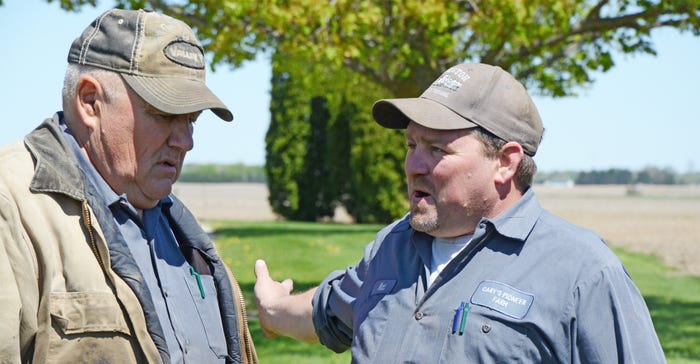
While towing a 24-row corn planter, Matt Cary split his time between checking the monitor and looking over his shoulder this spring. At the headland, it took just a minute to grab the wheel and turn around his Case IH 350 Stiger. It was go-time starting the second week of May for this Alma grower, who partners with his father and brother to farm 4,100 acres.
Cary managed to get in just 350 acres of corn before the rain hit earlier in the spring. However, the second week of May provided stellar weather to finish the job at Cary’s Pioneer Farms and throughout much of Michigan. “If I have good conditions, I can get 300-plus acres in a day,” he said at that time. And that he did, planting all of his 1,900 acres of corn in seven days. Waiting was frustrating, but he didn’t hurry it though. Planting — a job he’s done since he was 15 — requires patience and understanding of field conditions.
For the most part, Michigan farmers experienced a slightly delayed planting season this spring. As planters were being readied, cold and wet weather was followed by a very warm and dry spell. Some growers got into the fields then, according to Marilyn Thelen, Michigan State University Extension educator for crop and livestock systems. “It was a nice opportunity, but then cold and wet returned,” she says. “It was really up and down in terms of ideal planting conditions.”
Hot and windy weather conditions followed, opening a nice planting window, but bringing some challenges with spraying.
Nationally, the corn crop was more than 96% planted, according to USDA’s June 5 crop progress report. Indiana, Kansas, Michigan and Ohio each had about 10% yet to plant. At that time, soybean planting stood at 83% complete nationally and 75% done in Michigan — around 10% behind average. As of June 11, 69% of Michigan’s corn and 70% of soybeans were rated good to excellent.
The planning for planting at Cary’s Pioneer Farms started last September when the operation locked in seed units to secure the best price. Data from soil testing, yield and some of the farm’s own research plots were used to select varieties by the end of November.
Cary farms with his dad, Scott, and brother, Jake. Scott primarily takes on marketing and spraying, while Matt tends to the crops and oversees a feedlot with 2,300 head of cattle, with the help feedlot manager, Kris Welch. Jake’s focus is primarily in the farm shop with repairs and maintenance, as well as planting soybeans. There are also four other full-time employees and two part-time employees, which includes his son, Landen, 17. His daughter, Madelyn, 15, also helps with cattle records.
Getting busy
On a single sheet of paper labeled 2017 Corn, there are 37 parcels recorded on a spreadsheet with acreage and seed variety. Some are crossed off, while others have stars denoting work for the day.
As Matt pulled the planter up tight to an in-field irrigation system, several rows on the other side were not planting, as that would mean overlap. Eight years ago the farm invested in autosteer and the next year installed a row clutcher, which communicates through GPS what rows have already been planted and shuts off the rows where there is overlap. “It eliminates overlap, and it paid for itself in a year and half,” Matt says.
This year, facing about $15,000 worth of maintenance, the family instead opted to upgrade to a $50,000 DeltaForce Precision system. It automatically adjusts to soil type to apply hydraulic — not air — down and lift pressure on seed for uniform and prescribed depth. “Uniform seed placement is critical for us because we have so many variations of soil types. Even though I’m planting, I’m thinking about harvest and how a uniform stand will really pay off.”
About half the corn crop will go for cattle feed, while the rest is cash crop. It is rotated with wheat and soybeans. “I’m not as worried about the price of corn, as I am growing a good crop,” says Matt, referencing the added value he gets by running it through cattle.
Corn maturities on the farm range from 105 to 98. “I can gamble a little bit more with chopping and high-moisture corn,” he adds.
The Carys have embraced technology, much the same as Matt’s grandfather Charles Cary, who founded the farm in 1944. “He bought 260 acres and had no clue on how he was going to pay for it,” Matt says. “He bought a 1965 Case 1200 and was told that he would go bankrupt because it was too big of a tractor.”
Instead, Matt says, he worked endless hours, tiled the ground and put in a grain drying system when the neighbors were using corn cribs. “He really was a visionary,” Matt says. “Now, 95% of the ground we own is tiled and 75% of our rented ground is tiled.”
Charles, who passed away in late 2010, was also on the front cover of Michigan Farmer several years ago, which featured sprayer technology. And, even though Matt gives his grandfather much of the credit for the early beginnings of the farm, he says his Grandma Neoma supported Charles in everything he did. “She really was the backbone,” he adds.
As of June 12, Matt says corn and soybeans are all planted, and corn is sprayed and sidedressed.
About the Author(s)
You May Also Like






